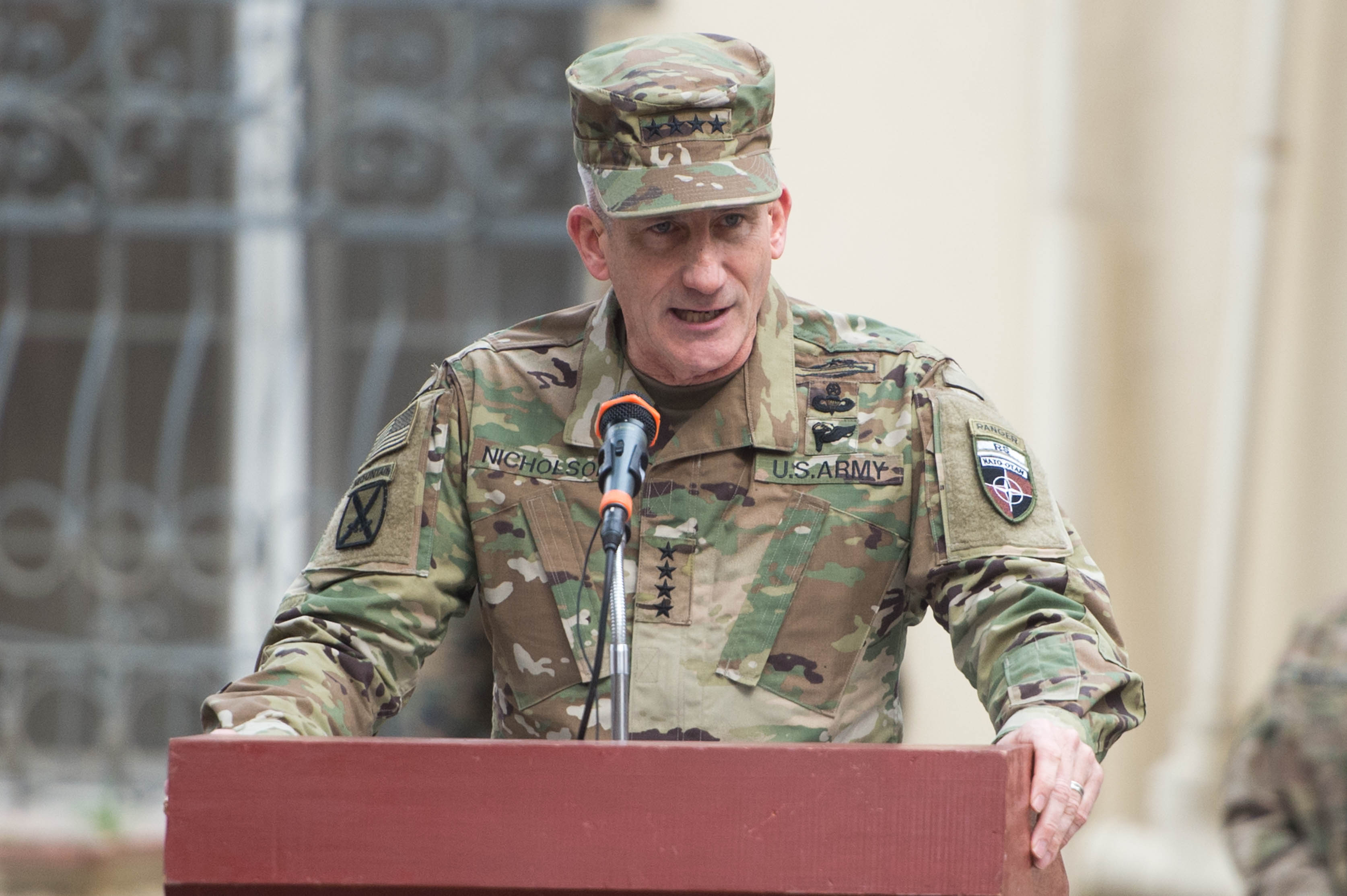
To break the military stalemate in Afghanistan, the commander of American and coalition forces there testified he needs “a few thousand” more troops for the train, advise and assist mission to succeed.
Army Gen. John Nicholson Jr., testifying Thursday before the Senate Armed Services Committee, said in answer to a question the additional forces “can come from our NATO allies” to do more advisory missions below the corps level with Afghan aviation and special forces units.
“There is an urgency to this request,” Nicholson said, particularly in aviation for close air support of ground forces. He added he believed he has sufficient forces to meet the current counterterrorism mission.
Nicholson was reluctant to mention specific numbers when pressed by Sen. Lindsey Graham (R-S.C.).
There are about 12,500 coalition forces, primarily from NATO countries, operating in Afghanistan now. Of those, 8,500 are Americans.
Graham asked Nicholson if 30,000 was enough and Nicholson said he would have to defer the answer to his chain of command.
“Offensive capabilities [aviation and special forces] will break the stalemate,” he told the panel.
He said the unity government under President Ashraf Ghani and Chief Executive Officer Abdullah Abdullah controls 57 percent of the nation’s districts, down from 72 percent.
Chairman John McCain, (R-Ariz.) said in his opening statement, in calling for additional American or coalition forces and new authorities for their use, “I want to stress the point, the Afghans are in the fight.” The new authorities for Nicholson’s command McCain referred to were primarily aimed at Pakistan, where a number of terrorist groups operate. “These sanctuaries must be eliminated.”
As to why 300 Marines will be deployed to Helmand Province in the spring, Nicholson said, “We needed to go in there with a permanent structure” to assist the Afghans in cutting off the Taliban’s revenue from opium trafficking. He earlier characterized the Taliban as a “narco-insurgency” and acknowledged that poppy production was up., increasing the funds available to them.
“Marines have a lot of experience in Helmand,” a rural province in the southwestern part of the country, he said. They first began operating in Helmand in 2001 when the first American forces arrived in Afghanistan following the terrorist attacks of Sept. 11, 2001.
Gen. Robert Neller, commandant, said last month when the deployment was announced the Marines have “no delusions about the difficulty and the challenges they’re going to face.”
In answering questions about the size of the force and continuing operations, Nicholson estimated there are twice as many contractors working in Afghanistan as American forces. A number of these are working in aviation maintenance because of caps on troop levels. The result, he said, is that the costs are higher for the civilians and soldiers do not receive the practical experience they were trained for at a cost to overall service readiness.
Sen. Claire McCaskill, (D-Mo.), put the cost of the contractors in Afghanistan at $100 billion over the last five years.

“I would rather see soldiers doing what soldiers are trained to do,” Nicholson said in response.
While Afghanistan has authorized its security forces end strength to exceed 350,000, the high casualties they are suffering, especially in its Special Forces units, means they are barely replacing combat losses.
In addition, “ghost soldiers” and “ghost police” are a continuing problem that Nicholson said is now being addressed. He said there were “tens of thousands fewer soldiers in the field than reported.”
The “ghost soldier” figure came from the latest report of the Special Inspector General for Afghanistan Reconstruction, issued in January.
Nicholson listed this as the second leading deficiency in the Afghan security forces. He put “failure of leaders in battle” as the most serious deficiency and lack of manpower for security checkpoints as third.
The United States “is withholding funds for soldiers we cannot biometrically account for” and not just paying for names appearing on unit rosters. The United States is paying the soldiers’ and police forces’ salaries.
He said the government and the United States are also taking steps “to better follow the money” in the Afghan logistics supply chain in a stronger effort to cut down corruption in that area.
Nicholson termed the government “a partner who will go boldly” after corruption and “a population and government who want to work with us” in defeating the Taliban and other terrorists.
Nicholson said the Afghans and Pakistanis are having to contend with 20 of the 98 State Department designated terrorist organizations, such as the Taliban, the Haqqani Network al Qaeda and others operating inside its borders or crossing over from Pakistan. With 200 million people and 70 percent of the population below 30 in both countries, “the conditions in the region lead to growth” in these organizations, a number of them willing to strike the United States, Nicholson said. Sen. Angus King, (I-Maine), called it a “petri dish” for terrorism.
The general termed the recent Russian involvement in Afghanistan as “publicly legitimizing the Taliban,” and he doubted whether Moscow was fighting the Islamic State affiliate centered on Khorasan Province.
Shia Iran, he added, is assisting the Sunni Taliban primarily in the western part of Afghanistan. ironically, he said Iran is also recruiting in those same provinces fighters to battle the Sunni Islamic State in Syria and Iraq. In addition, Tehran is financing fighters in the northern provinces of the country and Kabul, the capital, against the government.
The common goal of Iran and Russia is “to undermine the United States and NATO” in Afghanistan.
“We believe our operations in Afghanistan directly protect the United States homeland,” he said in answer to a question about the value of continuing the fight after 15 years. He cited the recent killing of a senior al Qaeda official in Afghanistan who was plotting an attack on the United States. “Our objective is to destroy them.”





